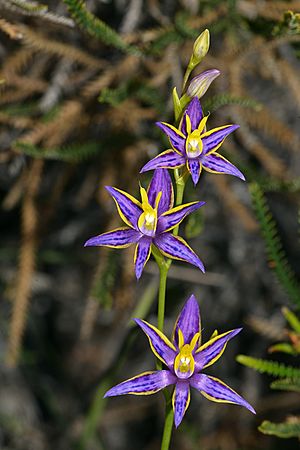Cleopatra's needles facts for kids
Quick facts for kids Cleopatra's needles |
|
|---|---|
 |
|
| Thelymitra apiculata | |
| Conservation status | |
| Scientific classification | |
| Genus: |
Thelymitra
|
| Species: |
apiculata
|
| Synonyms | |
|
|
Thelymitra apiculata, often called Cleopatra's needles, is a special type of orchid. It belongs to the orchid family and grows only in the south-west part of Western Australia.
This orchid has a single, tall, dark green leaf that curves a bit. Its flowers are usually purplish with darker spots and bright golden yellow edges. A cool feature is the two yellow "arms" on the flower's central part, called the column. Each arm ends in a sharp, needle-like point, which is how it got its common name, "Cleopatra's needles"!
Contents
What Cleopatra's Needles Look Like
Cleopatra's needles is a tuberous plant that lives for many years. It grows from a special underground storage part called a tuber. It has one upright, dark green leaf that is about 40 to 80 mm (1.6 to 3.1 inches) long. The bottom of the leaf is often purplish.
The plant produces between two and twelve shiny flowers. These flowers are bright purple or pinkish-purple with darker spots and golden yellow edges. Each flower is about 25 to 30 mm (1.0 to 1.2 inches) wide. They grow on a stem that can be 200 to 350 mm (7.9 to 14 inches) tall.
The sepals and petals (parts that look like petals) are about 12 to 17 mm (0.47 to 0.67 inches) long. The central part of the flower, the column, is the same color as the petals. It has two yellow arms that stand up straight, and each arm ends in a sharp, needle-like tip. You can see these beautiful flowers from late May to July.
How Cleopatra's Needles Got Its Name
This orchid was first officially described in 1984 by a scientist named Alex George. He found a sample near a place called Badgingarra in Western Australia. At first, he named it Thelymitra variegata var. apiculata.
Later, in 1989, two other scientists, David Jones and Mark Clements, decided it was unique enough to be its own species. So, they gave it the name T. apiculata. The second part of its scientific name, apiculata, comes from a Latin word meaning "small pointed." This refers to the short, needle-like tips on the column arms of the flower.
Where Cleopatra's Needles Grow
Thelymitra apiculata grows in specific areas of Western Australia. It likes to grow among low shrubs on top of low, reddish-brown hills called lateritic hills.
You can find this orchid in a few natural areas. These include the Geraldton Sandplains, the Jarrah Forest, and the Swan Coastal Plain. These are all different types of natural environments where this special orchid thrives.
Protecting Cleopatra's Needles
The Government of Western Australia's Department of Parks and Wildlife keeps an eye on plants like Cleopatra's needles. They have classified Thelymitra apiculata as "Priority Four".
This means that the plant is rare or almost threatened. It needs special attention and protection to make sure it continues to grow in the wild.


